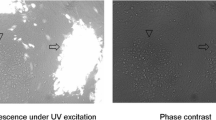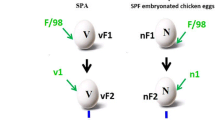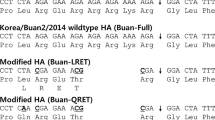Abstract
The avian influenza vaccine strain A/duck/Hokkaido/Vac-1/2004 (H5N1) (Vac-1) was found to be pathogenic in chicken embryos (CEs). In order to decrease the pathogenicity of Vac-1 in CEs, a series of reassortant viruses was generated between Vac-1 and A/Puerto Rico/8/1934 (H1N1) (PR8), and their pathogenicity and growth potential were compared in CEs. The results indicated that either the PB1 or PA protein was responsible for the pathogenicity of Vac-1 in CEs. The HA titers of the allantoic fluids of CEs inoculated with the recombinant H5N1 viruses, of which pathogenicity was lower than that of the recombinant Vac-1 prepared by reverse genetics in CEs, were equivalent to those of CEs inoculated with the recombinant Vac-1. One of the reassortant viruses, rg-PR8-PA/Vac-1 (H5N1), in which the PA gene was replaced with the corresponding gene of PR8, yielded allantoic fluids with the same HA titer as that of Vac-1, indicating that this reassortant should be a good candidate as an improved vaccine strain.

Similar content being viewed by others
References
Chen Z, Zhou H, Jin H (2010) The impact of key amino acid substitutions in the hemagglutinin of influenza A (H3N2) viruses on vaccine production and antibody response. Vaccine 28:4079–4085
Claas EC, Osterhaus AD, van Beek R, De Jong JC, Rimmelzwaan GF, Senne DA, Krauss S, Shortridge KF, Webster RG (1998) Human influenza A H5N1 virus related to a highly pathogenic avian influenza virus. Lancet 351:472–477
Dias A, Bouvier D, Crepin T, McCarthy AA, Hart DJ, Baudin F, Cusack S, Ruigrok RW (2009) The cap-snatching endonuclease of influenza virus polymerase resides in the PA subunit. Nature 458:914–918
Gambaryan AS, Robertson JS, Matrosovich MN (1999) Effects of egg-adaptation on the receptor-binding properties of human influenza A and B viruses. Virology 258:232–239
Hoffmann E, Neumann G, Kawaoka Y, Hobom G, Webster RG (2000) A DNA transfection system for generation of influenza A virus from eight plasmids. Proc Natl Acad Sci USA 97:6108–6113
Hoffmann E, Stech J, Guan Y, Webster RG, Perez DR (2001) Universal primer set for the full-length amplification of all influenza A viruses. Arch Virol 146:2275–2289
Horimoto T, Murakami S, Muramoto Y, Yamada S, Fujii K, Kiso M, Iwatsuki-Horimoto K, Kino Y, Kawaoka Y (2007) Enhanced growth of seed viruses for H5N1 influenza vaccines. Virology 366:23–27
Hulse-Post DJ, Franks J, Boyd K, Salomon R, Hoffmann E, Yen HL, Webby RJ, Walker D, Nguyen TD, Webster RG (2007) Molecular changes in the polymerase genes (PA and PB1) associated with high pathogenicity of H5N1 influenza virus in mallard ducks. J Virol 81:8515–8524
Isoda N, Sakoda Y, Kishida N, Soda K, Sakabe S, Sakamoto R, Imamura T, Sakaguchi M, Sasaki T, Kokumai N, Ohgitani T, Saijo K, Sawata A, Hagiwara J, Lin Z, Kida H (2008) Potency of an inactivated avian influenza vaccine prepared from a non-pathogenic H5N1 reassortant virus generated between isolates from migratory ducks in Asia. Arch Virol 153:1685–1692
Keiner B, Maenz B, Wagner R, Cattoli G, Capua I, Klenk HD (2010) Intracellular distribution of NS1 correlates with infectivity and interferon antagonism of an avian influenza virus (H7N1). J Virol 84:11858–11865
Kodihalli S, Justewicz DM, Gubareva LV, Webster RG (1995) Selection of a single amino acid substitution in the hemagglutinin molecule by chicken eggs can render influenza A virus (H3) candidate vaccine ineffective. J Virol 69:4888–4897
Lierz M, Hafez HM, Klopfleisch R, Luschow D, Prusas C, Teifke JP, Rudolf M, Grund C, Kalthoff D, Mettenleiter T, Beer M, Hardert T (2007) Protection and virus shedding of falcons vaccinated against highly pathogenic avian influenza A virus (H5N1). Emerg Infect Dis 13:1667–1674
Londt BZ, Banks J, Gardner R, Cox WJ, Brown IH (2007) Induced increase in virulence of low virulence highly [corrected] pathogenic avian influenza by serial intracerebral passage in chickens. Avian Dis 51:396–400
Lu B, Zhou H, Ye D, Kemble G, Jin H (2005) Improvement of influenza A/Fujian/411/02 (H3N2) virus growth in embryonated chicken eggs by balancing the hemagglutinin and neuraminidase activities, using reverse genetics. J Virol 79:6763–6771
Lu B, Zhou H, Chan W, Kemble G, Jin H (2006) Single amino acid substitutions in the hemagglutinin of influenza A/Singapore/21/04 (H3N2) increase virus growth in embryonated chicken eggs. Vaccine 24:6691–6693
Lugovtsev VY, Vodeiko GM, Levandowski RA (2005) Mutational pattern of influenza B viruses adapted to high growth replication in embryonated eggs. Virus Res 109:149–157
Maier HJ, Kashiwagi T, Hara K, Brownlee GG (2008) Differential role of the influenza A virus polymerase PA subunit for vRNA and cRNA promoter binding. Virology 370:194–204
OIE (2004) OIE manual of diagnostic tests and vaccines for terrestrial animals, 5th edn. World Organization for Animal Health, Paris
Regan JF, Liang Y, Parslow TG (2006) Defective assembly of influenza A virus due to a mutation in the polymerase subunit PA. J Virol 80:252–261
Sakabe S, Sakoda Y, Haraguchi Y, Isoda N, Soda K, Takakuwa H, Saijo K, Sawata A, Kume K, Hagiwara J, Tuchiya K, Lin Z, Sakamoto R, Imamura T, Sasaki T, Kokumai N, Kawaoka Y, Kida H (2008) A vaccine prepared from a non-pathogenic H7N7 virus isolated from natural reservoir conferred protective immunity against the challenge with lethal dose of highly pathogenic avian influenza virus in chickens. Vaccine 26:2127–2134
Sasaki T, Kokumai N, Ohgitani T, Sakamoto R, Takikawa N, Lin Z, Okamatsu M, Sakoda Y, Kida H (2009) Long lasting immunity in chickens induced by a single shot of influenza vaccine prepared from inactivated non-pathogenic H5N1 virus particles against challenge with a highly pathogenic avian influenza virus. Vaccine 27:5174–5177
Soda K, Ozaki H, Sakoda Y, Isoda N, Haraguchi Y, Sakabe S, Kuboki N, Kishida N, Takada A, Kida H (2008) Antigenic and genetic analysis of H5 influenza viruses isolated from water birds for the purpose of vaccine use. Arch Virol 153:2041–2048
Soda K, Sakoda Y, Isoda N, Kajihara M, Haraguchi Y, Shibuya H, Yoshida H, Sasaki T, Sakamoto R, Saijo K, Hagiwara J, Kida H (2008) Development of vaccine strains of H5 and H7 influenza viruses. Jpn J Vet Res 55:93–98
Swayne DE, Lee CW, Spackman E (2006) Inactivated North American and European H5N2 avian influenza virus vaccines protect chickens from Asian H5N1 high pathogenicity avian influenza virus. Avian Pathol 35:141–146
Webster RG, Webby RJ, Hoffmann E, Rodenberg J, Kumar M, Seiler P, Krauss S, Songserm T (2006) The immunogenicity and efficacy against H5N1 challenge of reverse genetics-derived H5N3 influenza vaccine in ducks and chickens. Virology 351:303–311
Welch BL (1938) The significance of the difference between two means when the population variances are unequal. Biometrika 29:350–362
WHO Cumulative number of confirmed human cases of avian influenza A/(H5N1). Reported to WHO, accessed at: http://www.who.int/csr/disease/avian_influenza/country/cases_table_2010_05_06/en/index.html
Xu X, Subbarao Cox NJ, Guo Y (1999) Genetic characterization of the pathogenic influenza A/Goose/Guangdong/1/96 (H5N1) virus: similarity of its hemagglutinin gene to those of H5N1 viruses from the 1997 outbreaks in Hong Kong. Virology 261:15–19
Yuan P, Bartlam M, Lou Z, Chen S, Zhou J, He X, Lv Z, Ge R, Li X, Deng T, Fodor E, Rao Z, Liu Y (2009) Crystal structure of an avian influenza polymerase PA(N) reveals an endonuclease active site. Nature 458:909–913
Acknowledgments
We are grateful to Dr. R. G. Webster, Dr. E. Hoffmann, and Dr. R. Webby, St. Jude Children’s Research Hospital, for kindly providing A/Puerto Rico/8/1934 (H1N1) and pHW72-EGFP. The present work was supported in part by the Program of Founding Research Centers for Emerging and Reemerging Infectious Disease from the Ministry of Education, Culture, Sports, Science, and Technology, Japan, and Japan Racing and Livestock Promotion Foundation. We want to thank Dr. K. Soda for providing much advice about this manuscript.
Author information
Authors and Affiliations
Corresponding author
Rights and permissions
About this article
Cite this article
Isoda, N., Sakoda, Y., Okamatsu, M. et al. Improvement of the H5N1 influenza virus vaccine strain to decrease the pathogenicity in chicken embryos. Arch Virol 156, 557–563 (2011). https://doi.org/10.1007/s00705-010-0890-y
Received:
Accepted:
Published:
Issue Date:
DOI: https://doi.org/10.1007/s00705-010-0890-y




